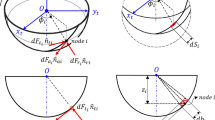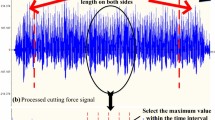Abstract
Cutting force is the fundamental parameter determining the productivity and quality of the milling operation. The development of a generic cutting force model for end milling operation necessitates a large number of experiments. The experimental data contains multiple outliers due to noise and process disturbances lowering prediction accuracy of the model. This paper presents a novel approach combining the mechanistic model and the supervised neural network (NN) model to predict instantaneous cutting force variation during the end milling operation. The approach proposes training of an NN model using datasets generated from the mechanistic force model instead of using experimental data. The methodology generates a large number of datasets for the training of an NN model without conducting rigorous experimentation. A set of NN architectures were developed, and an appropriate network was derived by comparing performance parameters. A series of end milling experiments were conducted to examine the efficacy of the proposed approach in predicting cutting forces over a wide range of cutting conditions.











Similar content being viewed by others
References
Al-Zubaidi, S., Ghani, J. A., & Haron, C. H. C. (2011). Application of ANN in milling process: A review. Modelling and Simulation in Engineering,2011, 7. https://doi.org/10.1155/2011/696275.
Armarego, E. J. A., & Deshpande, N. P. (1991). Computerized end-milling force predictions with cutting models allowing for eccentricity and cutter deflections. CIRP Annals,40(1), 25–29. https://doi.org/10.1016/S0007-8506(07)61926-X.
Briceno, J. F., El-Mounayri, H., & Mukhopadhyay, S. (2002). Selecting an artificial neural network for efficient modeling and accurate simulation of the milling process. International Journal of Machine Tools and Manufacture,42(6), 663–674. https://doi.org/10.1016/S0890-6955(02)00008-1.
Chen, S., Wu, Y., & Luk, B. L. (1999). Combined genetic algorithm optimization and regularized orthogonal least squares learning for radial basis function networks. IEEE Transactions on Neural Networks,10(5), 1239–1243. https://doi.org/10.1109/72.788663.
Chien, W. T., & Chou, C. Y. (2001). The predictive model for machinability of 304 stainless steel. Journal of Materials Processing Technology,118(1–3), 442–447. https://doi.org/10.1016/S0924-0136(01)00875-5.
Cus, F., & Balic, J. (2003). Optimization of cutting process by GA approach. Robotics and Computer-Integrated Manufacturing,19(1–2), 113–121. https://doi.org/10.1016/S0736-5845(02)00068-6.
Dang, J. W., Zhang, W. H., Yang, Y., & Wan, M. (2010). Cutting force modeling for flat end milling including bottom edge cutting effect. International Journal of Machine Tools and Manufacture,50(11), 986–997. https://doi.org/10.1016/j.ijmachtools.2010.07.004.
Dave, H. K., & Raval, H. K. (2010). Modelling of cutting forces as a function of cutting parameters in milling process using regression analysis and artificial neural network. International Journal of Machining and Machinability of Materials,8(1–2), 198–208. https://doi.org/10.1504/IJMMM.2010.034496.
Desai, K. A., Agarwal, P. K., & Rao, P. V. M. (2009). Process geometry modeling with cutter runout for milling of curved surfaces. International Journal of Machine Tools and Manufacture,49(12–13), 1015–1028. https://doi.org/10.1016/j.ijmachtools.2009.05.007.
Desai, K. A., & Rao, P. V. M. (2012). On cutter deflection surface errors in peripheral milling. Journal of Materials Processing Technology,212(11), 2443–2454. https://doi.org/10.1016/j.jmatprotec.2012.07.003.
Foresee, F. D., & Hagan, M. T. (1997). Gauss–Newton approximation to Bayesian learning. In Proceedings of international conference on neural networks (ICNN’97) (June) (Vol. 3, pp. 1930–1935). IEEE. https://doi.org/10.1109/icnn.1997.614194.
Hsieh, C. H., Chou, J. H., & Wu, Y. J. (2002). Optimal predicted fuzzy controller of a constant turning force system with fixed metal removal rate. Journal of Materials Processing Technology,123(1), 22–30. https://doi.org/10.1016/S0924-0136(02)00008-0.
Huang, P. B. (2016). An intelligent neural-fuzzy model for an in-process surface roughness monitoring system in end milling operations. Journal of Intelligent Manufacturing,27(3), 689–700. https://doi.org/10.1007/s10845-014-0907-6.
Huang, Z., Zhu, J., Lei, J., Li, X., & Tian, F. (2019). Tool wear predicting based on multi-domain feature fusion by deep convolutional neural network in milling operations. Journal of Intelligent Manufacturing. https://doi.org/10.1007/s10845-019-01488-7.
Ko, J. H., Yun, W. S., Cho, D. W., & Ehmann, K. F. (2002). Development of a virtual machining system, part 1: Approximation of the size effect for cutting force prediction. International Journal of Machine Tools and Manufacture,42(15), 1595–1605. https://doi.org/10.1016/S0890-6955(02)00137-2.
Law, K. M., Geddam, A., & Ostafiev, V. A. (1999). A process-design approach to error compensation in the end milling of pockets. Journal of Materials Processing Technology,89, 238–244. https://doi.org/10.1016/S0924-0136(99)00031-X.
Li, X. P., Nee, A. Y. C., Wong, Y. S., & Zheng, H. Q. (1999). Theoretical modeling and simulation of milling forces. Journal of Materials Processing Technology, 89, 266–272. https://doi.org/10.1016/S0924-0136(99)00076-X.
MacKay, D. J. (1992). Bayesian interpolation. Neural Computation,4(3), 415–447. https://doi.org/10.1162/neco.1992.4.3.415.
Malghan, R. L., Rao, K., Shettigar, A. K., Rao, S. S., & D’Souza, R. J. (2018). Forward and reverse mapping for milling process using artificial neural networks. Data in Brief,16, 114–121. https://doi.org/10.1016/j.dib.2017.10.069.
Martellotti, M. E. (1941). An analysis of the milling process. Transaction of the ASME,63(8), 677–700.
Quintana, G., Garcia-Romeu, M. L., & Ciurana, J. (2011). Surface roughness monitoring application based on artificial neural networks for ball-end milling operations. Journal of Intelligent Manufacturing,22(4), 607–617. https://doi.org/10.1007/s10845-009-0323-5.
Radhakrishnan, T., & Nandan, U. (2005). Milling force prediction using regression and neural networks. Journal of Intelligent Manufacturing,16(1), 93–102. https://doi.org/10.1007/s10845-005-4826-4.
Tandon, V., & El-Mounayri, H. (2001). A novel artificial neural networks force model for end milling. The International Journal of Advanced Manufacturing Technology,18(10), 693–700. https://doi.org/10.1007/s001700170011.
Tandon, V., El-Mounayri, H., & Kishawy, H. (2002). NC end milling optimization using evolutionary computation. International Journal of Machine Tools and Manufacture,42(5), 595–605. https://doi.org/10.1016/S0890-6955(01)00151-1.
Wan, M., & Zhang, W. H. (2009). Systematic study on cutting force modelling methods for peripheral milling. International Journal of Machine Tools and Manufacture,49(5), 424–432. https://doi.org/10.1016/j.ijmachtools.2008.12.004.
Wan, M., Zhang, W. H., Qin, G. H., & Wang, Z. P. (2008). Consistency study on three cutting force modelling methods for peripheral milling. Proceedings of the Institution of Mechanical Engineers, Part B: Journal of Engineering Manufacture,222(6), 665–676. https://doi.org/10.1243/09544054JEM1085.
Wang, Q., Jia, X., Hu, B., & Xia, W. (2019). A mechanistic prediction model of instantaneous cutting forces in drilling of carbon fiber-reinforced polymer. The International Journal of Advanced Manufacturing Technology. https://doi.org/10.1007/s00170-019-03571-y.
Zhang, Z., Zheng, L., Zhang, L., Li, Z., Liu, D., & Zhang, B. (2005). A study on calibration of coefficients in end milling forces model. The International Journal of Advanced Manufacturing Technology,25(7–8), 652–662. https://doi.org/10.1007/s00170-003-1903-8.
Zuperl, U., & Cus, F. (2004). Tool cutting force modeling in ball-end milling using multilevel perceptron. Journal of Materials Processing Technology,153, 268–275. https://doi.org/10.1016/j.jmatprotec.2004.04.309.
Zuperl, U., Cus, F., & Reibenschuh, M. (2012). Modeling and adaptive force control of milling by using artificial techniques. Journal of Intelligent Manufacturing,23(5), 1805–1815. https://doi.org/10.1007/s10845-010-0487-z.
Acknowledgements
The authors would like to thank the Department of Science and Technology—Science and Engineering Research Board (DST-SERB) and Ministry of Human Resource Development (MHRD), India, for providing financial support (Project No: YSS/2015/000495) to carry out this research work. The authors also express sincere thanks to Mr. Dhrumil Soni for assisting with conducting machining experiments.
Author information
Authors and Affiliations
Corresponding author
Ethics declarations
Conflict of interest
The authors declare that they have no conflict of interest.
Additional information
Publisher's Note
Springer Nature remains neutral with regard to jurisdictional claims in published maps and institutional affiliations.
Rights and permissions
About this article
Cite this article
Vaishnav, S., Agarwal, A. & Desai, K.A. Machine learning-based instantaneous cutting force model for end milling operation. J Intell Manuf 31, 1353–1366 (2020). https://doi.org/10.1007/s10845-019-01514-8
Received:
Accepted:
Published:
Issue Date:
DOI: https://doi.org/10.1007/s10845-019-01514-8




